
Our Geological Wonderland: Navajo Sandstone
There sure are a lot of red rocks in and around St. George, Utah. Geologists like to call such rocks “red beds.” Of particular interest are those red beds that occur with scenic splendor in Zion Canyon and Snow Canyon as well as also other areas in southern Utah and northern Arizona. The red color is due to small amounts of iron-bearing minerals that were incorporated into these rocks as they were forming in the geological past. Subsequently, those iron minerals have been exposed to the atmosphere and have become oxidized (literally rusted) over time, thereby producing the red color. The cemented grains making up the rock formation, which is known as Navajo Sandstone, makes it more resistant to weathering and erosion than other rocks in the area, and so the sandstone tends to remain as vertical cliffs many hundreds of feet or more in height. This makes for some spectacular scenery. What is also spectacular is the geologic and paleontologic information preserved within the rocks themselves. Trying to recognize and understand this information is much like a CSI study.
Typically, geologists have a generalized plan of research that is used to answer a set of questions relating to a particular rock formation such as Navajo Sandstone, and this plan involves various types of field work and laboratory study. A preliminary study is usually to identify what kind of rock is present, then determine some of its physical features such as its thickness and its geographic distribution on the surface. More detailed studies include studying characteristics of the layers (termed bedding or stratification), looking for fossils to determine the geological age, and looking at various interior features such as grain size and shape. Geologists use all this information to interpret ancient conditions and environments in which these rocks originally formed.
Since being named Navajo Sandstone early in the 1900s, many geologists have studied these rocks. The past century of research on the formation has provided a vast amount of information that has been used to answer the questions mentioned above. However, these rocks have not given up all their secrets easily, and over the years continuous study has resulted in numerous re-interpretations based on new discoveries. Geologists now have a reasonably accurate interpretation about the history of these colorful rocks, but some details will certainly change as new evidence is discovered and reported.
The first and most obvious determination is the fact that Navajo Sandstone is a sedimentary rock, so not surprisingly it consists mostly of sand-sized grains, which consist of a mineral called quartz (SiO2). This formation is known to be widespread in the southwestern United States and may range in thickness from a few hundred feet to over 2,000 feet. Although the predominant color is red, many variations occur, such as white, yellow, buff, and tan. Except for the white rocks, the various colors are due to the presence of trace amounts of different minerals.
In many locations within the boundaries of Zion Canyon, Snow Canyon, and other areas, the layers of sandstone are tilted with respect to one another, a feature that is termed cross-bedding or cross-stratification. In fact, this cross-bedding is one of the most distinctive features of the formation and has provided a major clue in how the rocks originally formed.

There are some interesting characteristics of the grains themselves. When looked at under a microscope, they are classified as relatively fine sand-sized grains (think of fine to medium sandpaper). They are also mostly similar in size to one another, and they have generally rounded, frosted, and pitted outlines. So what does all this information tell us? By comparing these features with sand deposited in modern environments, it becomes evident that we are looking at windblown sand dune deposits that formed back in geologic time. These sand dunes and other features within the sediments were gradually buried, and the grains became cemented together to form the rocks we call Navajo Sandstone.

Well, that interpretation brings up the question of just how long ago in the geologic past these sand dunes formed. That is a more difficult question to answer for two reasons. First is the fact that sedimentary rocks like these cannot be radiometrically dated. Second is the fact that there are overall very few age-diagnostic fossils preserved in these rocks, which is not surprising considering the conditions in which they were formed. Therefore, determination of the relative geologic age for these rocks has been difficult to pin down, although in recent years some new fossil discoveries have narrowed the geologic age down a bit.
Many fossils found in the Navajo Sandstone rocks are what are termed trace fossils since they provide a record of organism activity but not of the organism itself. Think “footprints in the sands of time.” Invertebrate burrows occur in some areas, and reptile and dinosaur footprints and trackways are known from some areas. Recently, some skeletal material (bones of vertebrates and shells of invertebrates) have been recovered. Collectively, these fossils and the known ages of underlying and overlying rocks have narrowed the age range to the Latest Triassic — Early Jurassic Periods. This time interval indicates a numerical range of 190–175 million years old for the rocks.
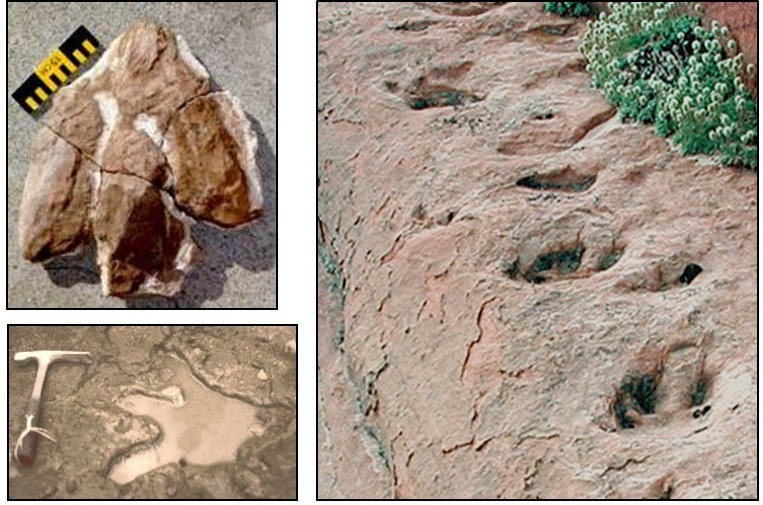
In some areas, small pockets of silty mudstone can be found. These represent water-deposited materials, and they indicate conditions similar to the temporary playa lakes found in desert basins today after rain storms. Similarly, pockets of dolomitic limestone have been found, and they are interpreted to represent fresh to brackish water oases. These interpretations are bolstered by the presence of fossilized tree trunks and various invertebrates such as ostracods and freshwater clams.
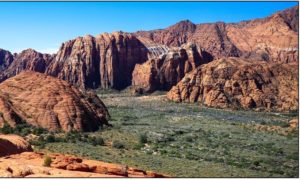
As it turns out, the Navajo Sandstone found in the Snow Canyon and Zion Canyon areas represents only a small portion of geologically similar rocks known from portions of surrounding states including Nevada, Arizona, New Mexico, Colorado, and Wyoming. In previous research studies, some of these rocks have been given different formation names, but they are now recognized to have formed in similar environments and are all of similar geologic age.
To fit this together into a big picture, what we have here in the St. George area and surrounding regions is literally an ancient sea of sand, which has been named the Navajo Erg.
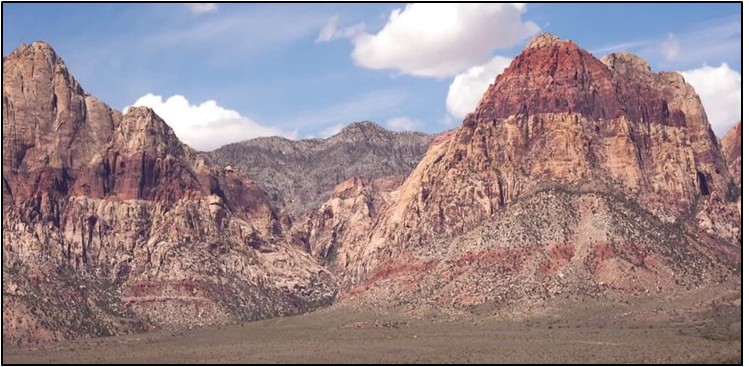
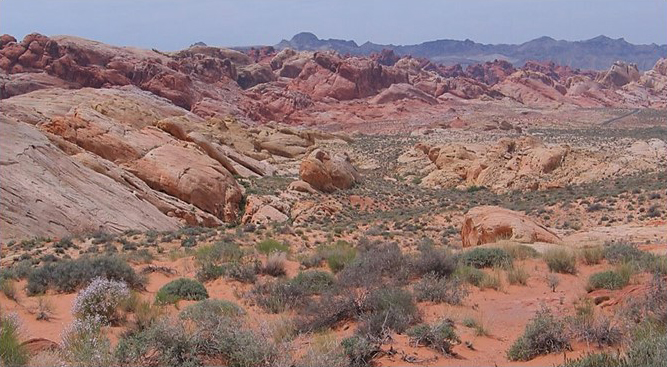
A modern example of a sand erg is illustrated below. As can be seen, it represents a “sea of sand.” Within such ergs, small, local areas may contain springs or be in areas where ground water is close to or at the surface. In such areas, an oasis may form. An oasis provides a haven for numerous plants and animals that can survive and make their homes in these areas and thus develop small communities. The localized pockets of limestone with fossils found within the Navajo Sandstone preserve evidence that such oases also existed in the ancient erg.
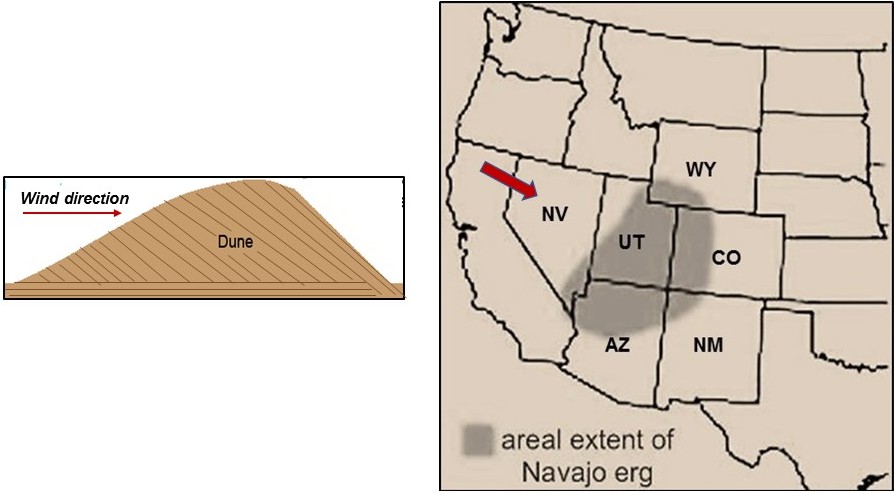
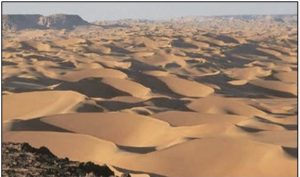
Over time, major changes have occurred in this region. Various changes in climate and geographic conditions eventually caused this sand erg to become buried by younger sediments, then the sand grains were cemented together, and thus this ancient dune field became preserved as part of the rock record. Within the very recent geologic past, this region has undergone further significant change resulting from plate tectonic activity. The western portion of North America has become a very active region geologically, with volcanic activity, earthquakes and faults, uplift of mountain ranges and the Colorado Plateau, and significant erosion of rocks. This erosion has once again exposed the sand erg, but now it is a sandstone erg.
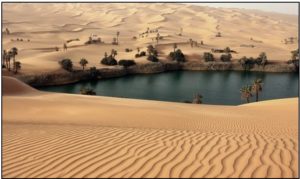
Snow Canyon State Park or Zion National Park, the two noted state parks in Nevada, and some of the other national parks and monuments such as Capitol Reef, Canyonlands, Escalante, and Glen Canyon provide some lovely scenery with a great bonus of understanding the geologic history of the rocks themselves. An expanded trip to all these locations offers the possibility of viewing a regional picture of nearly 200 million years ago time in the southwestern United States when a very large portion of area was mostly covered by a sea of wind-blown deposits of sand. Although fossils are rare at any of these specific locations, much of the physical evidence described in this brief article can easily be seen with even minimal observation and little hiking.
Much thanks to Janice Hayden, full time instructor of physical sciences at Dixie State University.
Articles related to “Our Geological Wonderland: Navajo Sandstone”
Our Geological Wonderland: The Pine Valley Mountain Laccolith




Hello to all, it’s genuinely a pleasant for me
to pay a visit this website, it contains helpful Information.
following reality taking into account that, of course you have to be careful in choosing a trusted gambling site to be a show partner.
We are here to help you tilt the difficulties and
cut a long showing off to locate the best and most trusted gambling agent and the safest ball in Indonesia.
The Mabosbet site is the most secure ball trusted trusted agent that has been providing the best assistance to its customers for years.
PAGCOR has an attributed license from an authorized body that oversees gambling regulations in the Asian region. This license guarantees the safest soccer
gambling agent that all games will be provided by Mabosbet guaranteed safe and have A-grade quality.
Sbobet is a trusted gambling site that operates to minister to all fans of online gambling in the world.
Founded in 2010, it didn’t receive long for Sbobet to become the biggest
online site in Asia and considering it comes to the amount of betting child support that rotates all week, Sbobet is as a consequence one of the
biggest sites in the world.
Sbobet is categorically popular, especially in the
middle of Asian bettors, the defense is that the site has
been awarded as the best gambling operator for two years in a row.
It offers a variant of football betting with definitely low margins taking into
consideration compared to supplementary sites in its class.
Probably the most Trusted Soccer Gambling Agent
in Indonesia Serving Provides of Gambling and On line casino Gambling
Userbola is the particular Most Trusted and Recognized
SBOBET Agent in Indonesia. We serve bets that will provide soccer gambling online games,
online gambling games, casino gambling agents, poker plus online lottery.
We will certainly wholeheartedly always be prepared to help whatever you want and help you if there
are difficulties in making SBOBET Online Betting Balances, MAXBET Agents or previously referred to as IBCBET, Serba4d or
KLIK4D lottery.
Fresh 20% Member Bonus with the particular Best and many Trustworthy Football Gambling Real estate agent
Userbola is usually the Best SGD777 Bandar plus the Biggest
Football Situs in Dalam negri, always providing 24-hour
online service with the need to stop along the way of registering, lodging, withdrawing and responding to your every complaint.
Regarding more information, please go directly to
livechat in addition to chat directly with our own friendly CS
Register regarding Sbobet right this moment!
Full Selection for Trustworthy Sports Wagering and On line casino Brokers
For you fans of betting soccer matches both international and domestic, reliable
football gambling provides various fits from all over the world.
Not necessarily simply that, basketball, tennis in addition to eSports
tournaments may also be here.
Especially for connoisseurs regarding Casino Providers, we possess the most complete range of online games which range from Baccarat, Online poker,
Keno, Slot Machine and several more.
Userbola is 1 of the trusted soccer betting sites that
acts as an agent of typically the tour’s major soccer betting shops such as
SBOBET, Ibcbet plus Mahabet Sport. You will definitely get a nice experience while betting due to interesting features proposed by this web site.
Userbola has a specialist service when you make down payment transaction until
pulling out cash.
Before you enter the sports gambling game on Userbola you must register 1st and become a user.
The strategy is very simple, all you have in order
to do is click on the list and enter the registration form page and you will proceed
directly to our main website.
I’m leaving a comment because I felt bad that the only comments here were spam… Surely you deserve better for such a wonderful, well-written article about the aeolian environments of deposition that formed the magnificent Lower Jurassic red sandstones of the southern Colorado Plateau.
Nice job on the geology…. and that comes from a fellow geologist.
Jeffrey Levine, Richardson, TX